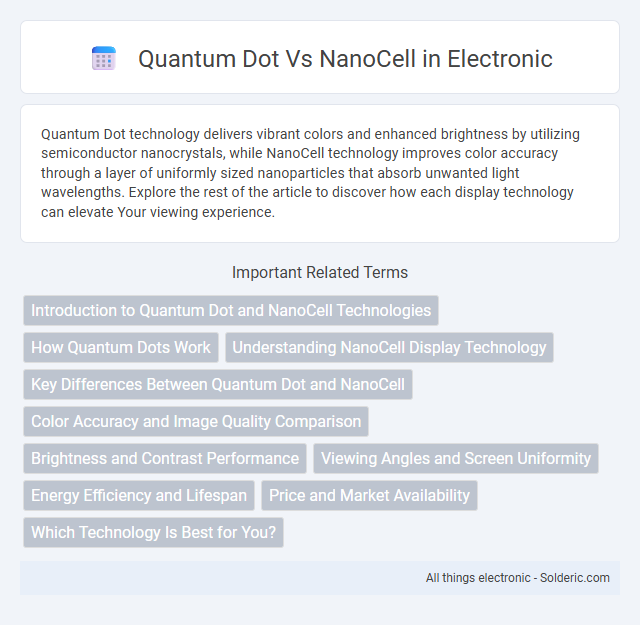Quantum Dot technology delivers vibrant colors and enhanced brightness by utilizing semiconductor nanocrystals, while NanoCell technology improves color accuracy through a layer of uniformly sized nanoparticles that absorb unwanted light wavelengths. Explore the rest of the article to discover how each display technology can elevate Your viewing experience.
Comparison Table
| Feature | Quantum Dot (QLED) | NanoCell |
|---|---|---|
| Display Technology | Uses quantum dots to enhance color and brightness | Uses nanoparticles to absorb unwanted light wavelengths |
| Color Accuracy | Superior color volume with vibrant, precise colors | Good color accuracy with improved purity |
| Brightness | Higher peak brightness, ideal for HDR content | Moderate brightness, less suitable for very bright environments |
| Viewing Angles | Wide viewing angles with minimal color shift | Improved viewing angles compared to standard LCD |
| Black Levels | Better black contrast but depends on backlight type | Decent blacks, sometimes affected by LCD limitations |
| Price Range | Generally higher due to advanced technology | Affordable mid-range option |
| Best For | Bright room viewing, HDR enthusiasts, vivid colors | Casual viewing, good color quality at a lower price |
Introduction to Quantum Dot and NanoCell Technologies
Quantum Dot technology utilizes semiconductor nanocrystals to enhance color accuracy and brightness on LED displays, producing vibrant and lifelike images. NanoCell technology employs a layer of uniformly sized nanoparticles to filter out dull colors and improve purity, resulting in more precise and consistent color reproduction. Both technologies significantly elevate LCD TV performance by optimizing light and color output through advanced materials.
How Quantum Dots Work
Quantum dots are semiconductor nanocrystals that emit precise colors by fluorescing when exposed to light or electricity, enabling displays to achieve purer and more accurate color reproduction. Unlike NanoCell technology, which uses a uniform layer of nanoparticles to filter and refine colors, quantum dots harness size-dependent quantum mechanics to produce highly saturated hues and increased brightness. This fundamental difference allows quantum dot displays to deliver superior color volume and energy efficiency compared to conventional LED LCD screens.
Understanding NanoCell Display Technology
NanoCell display technology uses a layer of uniformly sized nanoparticles to filter out dull colors and enhance color purity, delivering vibrant and accurate images on LCD panels. Unlike Quantum Dot displays, which rely on quantum particles to emit light at specific wavelengths, NanoCell improves color accuracy by absorbing unwanted wavelengths before they reach the backlight, resulting in sharper, more lifelike visuals. This technology enhances viewing angles and produces consistent colors regardless of the viewer's position, making it ideal for immersive and wide-angle TV experiences.
Key Differences Between Quantum Dot and NanoCell
Quantum Dot displays use semiconductor nanocrystals to produce precise, vibrant colors and higher brightness, enhancing color accuracy and energy efficiency. NanoCell technology employs uniformly sized nanoparticles that filter out dull colors, delivering consistent, accurate hues and wider viewing angles. Key differences include Quantum Dot's superior color volume and brightness levels, while NanoCell excels in maintaining color fidelity and wider viewing stability.
Color Accuracy and Image Quality Comparison
Quantum Dot displays offer superior color accuracy and a wider color gamut compared to NanoCell technology, producing more vivid and true-to-life images. NanoCell utilizes nanoparticles to filter and enhance colors, improving consistency and viewing angles, but typically falls short in peak brightness and color volume against Quantum Dot. For viewers prioritizing precise color reproduction and brighter, more dynamic images, Quantum Dot holds a distinct advantage in image quality performance.
Brightness and Contrast Performance
Quantum Dot technology delivers superior brightness and enhanced color accuracy by utilizing semiconductor nanocrystals that emit pure, vibrant light. NanoCell displays improve contrast by using a layer of nanoparticles to absorb unwanted light wavelengths, resulting in deeper blacks and more precise color reproduction. In terms of overall performance, Quantum Dot panels generally provide higher peak brightness, while NanoCell excels in maintaining consistent contrast across various viewing angles.
Viewing Angles and Screen Uniformity
Quantum Dot displays typically offer wider viewing angles and better color consistency compared to NanoCell technology, ensuring vibrant and accurate colors from various perspectives. NanoCell screens, however, use a particle layer to enhance color purity but may experience slight shifts in brightness and color accuracy when viewed off-center. Your choice depends on whether uniformity and wider viewing angles or enhanced color purity in center viewing are more critical for your viewing environment.
Energy Efficiency and Lifespan
Quantum Dot displays offer superior energy efficiency by utilizing nanocrystals that emit more vibrant colors with less power consumption compared to NanoCell technology, which relies on a color filter layer that can reduce brightness and increase energy use. In terms of lifespan, Quantum Dot panels generally exhibit greater durability and resistance to color degradation over time, whereas NanoCell displays may experience faster aging effects due to organic components in their LCD structure. This makes Quantum Dot technology a more sustainable choice for long-term, energy-conscious users seeking vivid picture quality.
Price and Market Availability
Quantum Dot TVs generally command higher prices than NanoCell models due to advanced color accuracy and brightness features, appealing to premium market segments. NanoCell TVs are more affordable and widely available, targeting budget-conscious consumers while maintaining solid color performance. Both technologies are readily accessible through major electronics retailers, but Quantum Dot screens are often limited to mid-to-high-end market tiers.
Which Technology Is Best for You?
Quantum Dot technology offers superior color accuracy and brightness by using nanocrystals that emit precise wavelengths of light, ideal for users seeking vivid visuals and advanced HDR performance. NanoCell TVs utilize a layer of uniformly sized nanoparticles to filter out dull colors, providing more natural and consistent viewing angles, which is perfect for family rooms and wide-angle seating. Choose Quantum Dot for enhanced color vibrancy and brightness, while NanoCell suits viewers prioritizing color consistency and broader viewing comfort.
Quantum Dot vs NanoCell Infographic

 solderic.com
solderic.com